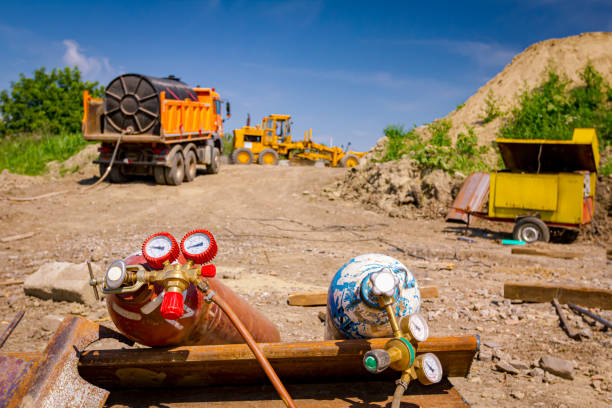Against the background of rapid urban expansion and population density, landfills are still an indispensable way of solid waste treatment in many areas. However, during its operation, the generation and accumulation of methane gas often become potential safety hazards. Methane is not only highly flammable and explosive, but also affects the surrounding air quality, thereby threatening the safety of the environment and personnel. Therefore, it is crucial to build a scientific and efficient emergency response mechanism combined with advanced gas detection technology for landfill management.
1. Source And Risk Analysis Of Methane Leakage
During the landfill process, especially under anaerobic conditions, the organic part of garbage will undergo anaerobically decompose under the action of microorganisms to generate methane, carbon dioxide and other gases. These gases rise through the pores inside the landfill and eventually escape into the atmosphere. If the landfill design is unreasonable or the exhaust system is damaged, methane may accumulate underground or on the surface to form a high concentration area.
The explosion limit of methane is 5% to 15% (volume fraction). When the concentration is within this range, it may cause a violent explosion once it encounters a fire source. In addition, methane itself is a colorless and odorless gas. If it is not continuously monitored by equipment, it is very easy to be ignored and cause emergencies.
2. The Core Links Of The Emergency Response Mechanism
In order to effectively deal with the risks brought by methane leakage, landfills need to build a scientific and systematic emergency response mechanism, which usually includes the following core links:
①Establishment of a risk warning system
Risk warning is the prerequisite for emergency response. Landfills need to deploy high-sensitivity methane detection equipment in key areas, such as working faces, gas wells, closed areas and field boundaries. These devices should have real-time monitoring capabilities, be able to continuously collect methane concentration data, and automatically alarm when the concentration exceeds the standard.
Modern methane detection equipment uses the principle of laser absorption spectroscopy (such as TDLAS technology), with the characteristics of fast response, high sensitivity, and strong anti-interference, which is particularly suitable for leak monitoring in complex environments. This type of detector usually supports multi-point control, and can synchronously transmit monitoring data to the control center through a wireless network to achieve centralized data management and analysis.
②Emergency plan and drill system
For different levels of methane leakage risks, landfills should formulate detailed emergency plans to clarify warning thresholds, response levels, personnel division of labor, emergency material allocation and other contents. Once a leakage incident occurs, the corresponding level of response procedures should be quickly initiated to carry out personnel evacuation, warning blockade, leakage blocking and other disposal work.
At the same time, emergency drills involving all employees should be organized regularly to test the practicality of the plan and the emergency response capabilities of employees through simulation drills, and continuously optimize the emergency mechanism.
③Real-time communication and decision-making command system
In the emergency response process, rapid information flow and unified command and dispatch are crucial. Landfills can achieve efficient linkage between detection equipment, operators and management centers by establishing an emergency communication platform. For example, when the detection equipment detects abnormal concentrations, the system will automatically send SMS or APP notifications to managers, and upload them to the dispatch platform simultaneously to ensure that information is obtained and responses are organized in the first time.
The platform also has a visual interface that can view the gas concentration change trend, alarm records and response processing procedures of each monitoring point in real time, providing data support and decision-making basis for managers.
3. The Application Value Of Technical Support In Emergency Response
In the emergency response of methane leakage in landfills, advanced technical equipment is the core support for improving efficiency and accuracy.
① Multi-scenario adaptability
Currently, high-performance methane detectors used in landfills usually have multiple forms such as portable, fixed and drone-mounted, which are suitable for different monitoring needs. For example, portable equipment is suitable for inspection and emergency investigation, fixed equipment is suitable for long-term control of key areas, and detectors mounted on drones can achieve high-altitude rapid scanning and quickly lock leakage points.
② Accurate positioning and traceability
Methane detection equipment equipped with laser ranging and GPS positioning functions can accurately calibrate the geographical coordinates of the leakage point. In the event of a leak, management personnel can quickly rush to the scene according to the location map provided by the system, shorten the investigation time and improve the disposal efficiency. In addition, the traceability of data also provides technical support for accident investigation and responsibility determination.
③ Data analysis and trend warning
High-end methane detectors can not only record real-time data, but also analyze trends through historical data to predict potential leakage risks. For example, during the rainy season or deformation period of the landfill area, if the concentration at a certain monitoring point continues to rise but does not exceed the alarm threshold, the system can issue a trend warning to guide managers to intervene in advance to prevent problems before they happen.
4. Summary and Outlook
Methane leakage is one of the main safety hazards in landfill operation, and an effective emergency response mechanism is the last line of defense to ensure environmental safety. By establishing a closed-loop response system with multi-point real-time monitoring, intelligent early warning, scientific plans, and rapid disposal, landfill managers can calmly respond to emergencies and minimize the damage caused by leakage.
Looking to the future, with the integration of the Internet of Things, big data, and artificial intelligence technologies, methane leakage emergency response will develop in a more intelligent and automated direction. Landfills will no longer just passively respond to risks, but will also have the ability to actively perceive and predict ahead of time, building a solid barrier for urban environmental safety.

